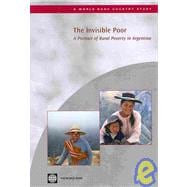
Note: Supplemental materials are not guaranteed with Rental or Used book purchases.
Purchase Benefits
Looking to rent a book? Rent The Invisible Poor A Portrait of Rural Poverty in Argentina [ISBN: 9780821382073] for the semester, quarter, and short term or search our site for other textbooks by World Bank; Demombynes, Gabriel; Verner, Dorte. Renting a textbook can save you up to 90% from the cost of buying.
| Acknowledgments | p. vii |
| Preface | p. viii |
| Abbreviations and Ackronyms | p. ix |
| Executive Summary | p. x |
| The Nature of Rural Poverty in Argentina | p. x |
| A Qualitative Study of Rural Poverty in Argentina | p. xiv |
| Measuring Poverty and Welfare in Rural Poverty Analysis | p. xvi |
| Issues and Challenges for Rural Poverty in Argentina | p. 1 |
| Introduction | p. 1 |
| Demographic Trends | p. 2 |
| Measuring Poverty | p. 7 |
| A Poverty Profile for Rural Argentina | p. 12 |
| The Need for Data: Poverty Monitoring and Evaluation of Rural Programs | p. 27 |
| A Qualitative Study of Rural Poverty in Argentina | p. 29 |
| Introduction | p. 29 |
| Methodology for Qualitative Survey | p. 30 |
| Sociodemographic Characteristics | p. 30 |
| Aspirations, Conflict, and Discrimination | p. 53 |
| Extreme Poverty | p. 56 |
| Methodology for the Analysis of Rural Poverty in Argentina | p. 60 |
| Introduction | p. 60 |
| Past Rural Household Surveys in Argentina | p. 60 |
| Rural Surveys in Other Countries of Latin America | p. 64 |
| Choice of Welfare Measure: Options for Argentina | p. 68 |
| Conclusions | p. 71 |
| References | p. 74 |
| Annexes | p. 79 |
| Poverty / UBN | p. 81 |
| Access to Services | p. 83 |
| Living / Housing | p. 84 |
| Population Statistics | p. 88 |
| Work Related | p. 91 |
| Contact Persons List for Field Activities and Focus Group Members | p. 94 |
| Chaco Province | p. 94 |
| Chaco province | p. 94 |
| Jujuy Province | p. 95 |
| Tucumán Province | p. 96 |
| Mendoza Province | p. 96 |
| Pobreza Rural en Argentina Estudio Cualitativo (Abril-Mayo 2007) | p. 102 |
| Guía de preguntas | p. 102 |
| Tables | |
| Population in Argentina and its Regions, 1991 and 2001 | p. 3 |
| Farm Residents in the 1998 and 2002 Agricultural Censuses | p. 11 |
| Incidence of Poverty for Selected Provinces, 2003 | p. 14 |
| Maximum Level of Education Attained in Argentina (Percent) | p. 15 |
| School Attendance in Rural and Urban Argentina, 2001 (Percent) | p. 16 |
| Indicators for Sampled Rural Areas in Argentina | p. 31 |
| Summary of Social Issues based on Qualitative Households Survey (2007) | p. 32 |
| Summary of Focus Group Findings | p. 34 |
| Summary of Focus Groups | p. 36 |
| Values of the Inverse Engel Coefficient Used in Latin America | p. 71 |
| Poverty According to Unsatisfied Basic Needs by Province (Percent) | p. 81 |
| Poverty According to Unsatisfied Basic Needs by Education of Household Head (Percent) | p. 82 |
| Poverty According to Unsatisfied Basic Needs by Age of Household Head (Percent) | p. 82 |
| Poverty According to Unsatisfied Basic Needs by Size of Household (Percent) | p. 82 |
| Unsatisfied Basic Needs Indicators (Percent) | p. 83 |
| Access to Public Services (Percent) | p. 83 |
| Access to Water (Percent) | p. 83 |
| Source of Water for Drinking and Cooking (Percent) | p. 84 |
| Health Insurance (Percent) | p. 84 |
| Type of Housing (Percent) | p. 84 |
| Quality of Material of Housing (Percent) | p. 85 |
| Rooms Per Person (Percent) | p. 85 |
| Contractual Housing Situation (Percent) | p. 85 |
| Sanitation (Percent) | p. 86 |
| Possession of Assets (Percent) | p. 86 |
| Kitchen (Percent) | p. 86 |
| Table of Contents provided by Ingram. All Rights Reserved. |
The New copy of this book will include any supplemental materials advertised. Please check the title of the book to determine if it should include any access cards, study guides, lab manuals, CDs, etc.
The Used, Rental and eBook copies of this book are not guaranteed to include any supplemental materials. Typically, only the book itself is included. This is true even if the title states it includes any access cards, study guides, lab manuals, CDs, etc.